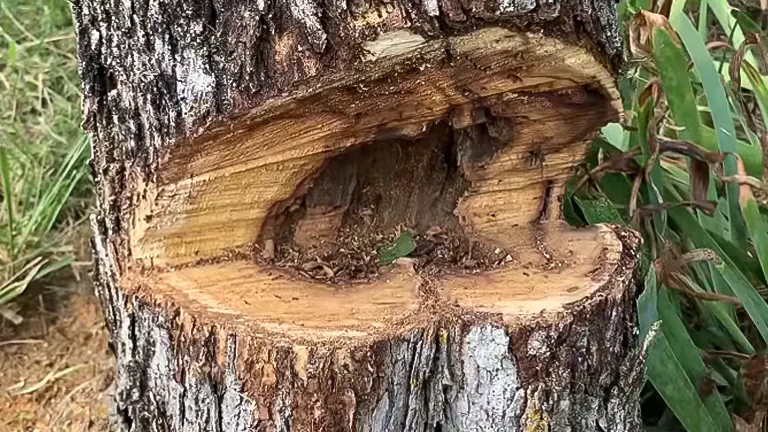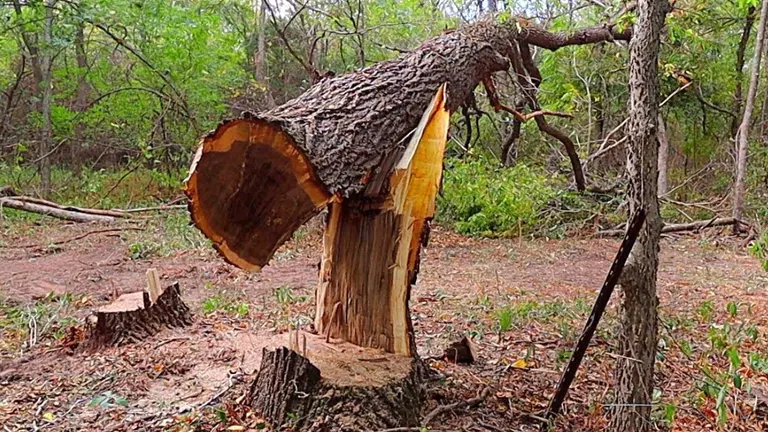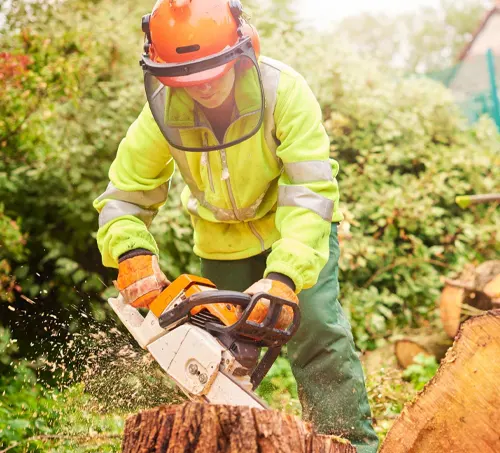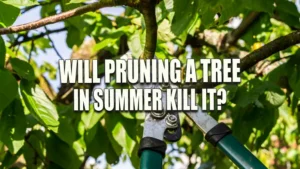How to Cut Down a Tree Safely: Guide to Tree Felling
- December 4, 2023
- 0 comment
Cutting down a tree can be essential for yard maintenance, landscaping, or forestry work, but it’s a task that requires both skill and a focus on safety. Knowing proper tree felling techniques and following safety guidelines is crucial to protect yourself and your surroundings. In this guide, I’ll share practical steps and tips to help you safely remove a tree while minimizing risks.
The Three Essential Components of Tree Felling
Tree felling is a careful process that combines precision, understanding how trees behave, and following safety protocols. The three key elements of safe tree cutting are the wedge, the hinge, and the back cut. These components work together to control the tree’s fall and keep the process safe and efficient.
1. The Wedge Cut: Setting the Direction
The wedge cut is the first and most crucial step in tree felling, as it determines the direction of the tree’s fall. This cut goes about one-third into the trunk and creates a clear path for the tree to follow. Precision is key here it ensures the tree falls safely and prevents any uncontrolled movement that could cause accidents.

2. The Hinge: The Control Mechanism
After making the wedge cut, the hinge becomes the key to controlling the tree’s fall. This intact strip of wood acts as a pivot, guiding the tree as it descends. Ideally, the hinge should be about one to one and a half inches thick, depending on the tree’s size and species. A properly sized hinge provides enough strength to control the fall while allowing the tree to bend safely in the desired direction. This step is crucial to avoid unpredictable or dangerous movements.

3. The Back Cut: Initiating the Fall
The back cut is the final step that triggers the tree’s fall. Positioned slightly above the wedge cut, it’s designed to preserve the hinge’s strength and ensure a controlled descent. This cut should be parallel to the wedge cut to maintain a consistent hinge width, allowing the tree to fall safely in the intended direction. Precision is vital here a poorly executed back cut can cause the tree to split or fall unpredictably, increasing the risk of accidents.

Understanding and accurately executing the wedge, hinge, and back cut is essential for safe and effective tree felling. Each component has a specific function and requires careful attention to detail.
Step-by-Step Process of Felling a Tree
Step 1: Starting with the Wedge Cut

The first step in tree felling is creating the wedge cut. This horizontal cut is typically made at waist height for better control and to guide the tree’s fall effectively. Use your chainsaw’s markings to ensure the cut is aligned with the intended direction. Precision is critical the top and bottom of the wedge must meet cleanly. Avoid overcutting, as it can compromise control over the tree’s fall, increasing the risk of accidents. Take your time to cut just enough for a safe and controlled descent.
Step 2: Establishing the Hinge

After completing the wedge cut, the next step is forming the hinge a crucial strip of wood left uncut between the wedge and back cuts. The hinge serves as a pivot, guiding the tree’s fall in the desired direction. Its thickness should be consistent and no more than one and a half inches. This balance ensures the tree falls smoothly while maintaining control. A uniform hinge width is essential for a predictable and safe descent, so take care to keep it even throughout.
Step 3: Executing the Back Cut

The back cut is the final step that releases the tree for its fall. It’s made parallel to the wedge cut and slightly above it to maintain the hinge’s integrity. This cut is critical for controlling the fall direction, so it’s important to ensure the hinge width remains consistent throughout. Extra care is needed when working with large trees or those with a significant lean, as these factors can impact stability and the tree’s descent. Approach this step methodically to ensure a safe, controlled fall and avoid unexpected splitting or movement.
Common Mistakes and How to Avoid Them
When felling a tree, certain common mistakes can significantly increase the risk of injury or property damage. Understanding these mistakes and knowing how to avoid them is crucial for safe and effective tree felling:
Overcutting the Wedge

Overcutting the wedge cut is a common mistake that can have dangerous consequences. If the cut goes too deep or extends beyond its intended point, it can create upward force on the hinge, causing a hazardous situation known as a “barber chair.” In this scenario, the tree splits vertically and falls unpredictably, increasing the risk of injury or property damage. To prevent this, ensure the wedge cut is precise no deeper than necessary and that the top and bottom cuts meet cleanly without overshooting their intersection. Careful measurement and attention to detail are essential for safety.
Inconsistent Hinge Width

A consistent hinge is crucial for safely guiding the tree’s fall. If the hinge is too thin on one side or too thick on the other, the tree might veer off course, creating a serious safety hazard. This can endanger the feller and nearby property. To prevent this, focus on maintaining uniform thickness throughout the hinge. Using your chainsaw’s guide bar as a reference can help ensure precision and consistency, keeping the tree’s descent controlled and predictable.
Improper Back Cut Position

Positioning the back cut correctly is critical for a safe and controlled tree fall. If the back cut is too high, it can weaken the hinge, reducing its ability to guide the tree. Conversely, a back cut that’s too low can prevent the tree from falling as intended. The back cut should always be parallel to and slightly above the wedge cut to maintain the hinge’s effectiveness. As you make the cut, monitor the tree closely—when it starts to lean or crack, stop cutting, as this signals the fall is beginning.
To avoid mistakes throughout the tree-felling process, focus on careful planning, precise cuts, and staying alert to the tree’s behavior. Regular practice and guidance from experienced tree fellers can build your skills. Above all, take your time rushing increases the risk of errors that could lead to accidents.
Advanced Techniques and Safety Measures
Advanced techniques and safety measures are crucial in tree felling, especially in challenging situations. These practices not only enhance control over the tree’s fall but also significantly increase the safety of the operation:
Using Ropes for Control
When a tree poses higher risks such as an unnatural lean or proximity to buildings ropes can significantly enhance control. Attaching ropes to the upper parts of the tree allows you to guide its fall with greater precision. A rope puller is especially helpful, as it enables you to apply controlled tension in the desired direction. This method is invaluable for preventing trees from falling on structures, power lines, or other critical areas. Ensure the ropes are strong enough to handle the tree’s weight and forces, and anchor them securely for maximum safety and effectiveness.

Safety Gear
Wearing the right personal protective equipment (PPE) is a must when felling trees. A hard hat protects you from falling branches and debris, while safety glasses or a face shield shield your eyes. Hearing protection is crucial to guard against the loud noise of chainsaws, and cut-resistant clothing helps prevent serious injuries from accidental contact with the blade. Don’t forget gloves for a secure grip and sturdy boots with good traction for stability. This gear is especially vital when working with dead or partially alive trees, as their unpredictability increases the risk of falling limbs or sudden movement.

Planning and Observation
Effective tree felling starts with careful planning and vigilant observation. Before making any cuts, decide on the tree’s fall direction, map out your cuts, and plan your escape routes. As you work, watch the tree closely for signs like cracking sounds or shifts in its lean these can signal that it’s about to fall. Be ready to adapt your approach if the tree behaves unexpectedly. A clear escape route is essential; the safest option is a 45-degree angle away from the fall direction, allowing you to move quickly to safety when the tree begins to descend.

Escape Routes in Tree Felling
Escape routes in tree felling are critical for ensuring the safety of the individual performing the felling. They are pre-planned paths that the feller uses to quickly and safely move away from the tree as it begins to fall. Here’s a closer look at their importance and how to plan them:
Importance of Escape Routes
- The primary purpose of an escape route is to provide a clear and immediate path to safety once the tree starts to fall. Trees can behave unpredictably as they fall, and having a predetermined escape route reduces the risk of being caught in the fall path or by rebounding debris.
- Escape routes are a part of the overall preparedness for tree felling. They are considered as important as the cutting technique itself.
- scape routes help in avoiding injuries that can occur due to the tree kicking back or other unexpected movements during the fall.
Planning Escape Routes
- Ideally, have at least two escape routes planned. This provides options in case one path becomes obstructed or unsafe due to the tree’s fall direction or other unforeseen circumstances.
- Escape routes should generally be planned at a 45-degree angle from the direction of the fall on either side of the tree. This angle tends to be the safest as it avoids both the direct fall line and the potential path of the tree kicking backward.
- Ensure that the escape routes are clear of obstacles. Remove any brush, branches, or equipment that might hinder a quick and unhindered exit.
- The escape route should extend a safe distance away from the base of the tree, ideally at least 20 feet or more, depending on the size of the tree.
- Throughout the felling process, remain aware of your escape routes. Keep in mind that as the tree begins to fall, conditions can change rapidly.
- Before making the first cut, physically walk your escape routes. This practice ensures familiarity with the path and can help you navigate it quickly during the actual felling.
- If working with a team, make sure everyone is aware of the escape routes and the plan of action once the tree begins to fall.
Escape routes are an integral part of the tree felling process, providing a crucial safety mechanism for the individual performing the work. Proper planning, clearing, and familiarity with these routes are essential for minimizing the risk of accidents and injuries during tree-felling operations.
Conclusion
Safely felling a tree is a skill that requires a blend of precise technique, respect for nature, and a strong commitment to safety. This guide has highlighted the importance of mastering the wedge, hinge, and back cut while avoiding common mistakes that can compromise safety. By using advanced tools like ropes for added control, wearing essential safety gear, and following careful planning and observation practices, you can approach tree felling with confidence and caution.
Every tree is unique, and each felling scenario presents its own challenges. Whether you’re a professional arborist or a homeowner tackling DIY yard care, the principles in this guide are your foundation for safe and effective tree removal. Always prioritize safety, respect your surroundings, and plan every step carefully.
Remember, the goal isn’t just to bring down a tree but to do so responsibly and safely. With the right approach, each job becomes a testament to your skill and care. Happy felling, and stay safe!
Related Articles:
- How To Sharpen A Chainsaw Properly: Tips and Tricks
- Best Top Handle Chainsaw: Forestry Choice
- 10 Best STIHL Chainsaws of 2023: Forestry Choice
- 12 Best Pole Saws of 2023
- Chainsaw Length Guide
- 10 Best Husqvarna Chainsaws
FAQs
- Can I use a drone to assess a tree before felling it?
Absolutely! Using a drone can provide a unique aerial view and help assess the tree’s condition, lean, and the surrounding area for potential hazards. This is especially useful for large trees or those in complex environments. - Is there a way to predict how a dead or partially alive tree will fall?
Predicting the fall of a dead or partially alive tree is more challenging due to the unpredictable nature of the wood. However, using techniques like sounding (tapping the tree with an axe and listening to the sound) can give clues about the internal structure and stability. - How does weather affect tree felling?
Weather conditions play a significant role. High winds can make felling dangerous, while wet conditions can make the area slippery. It’s best to perform tree felling in calm, dry weather. - Can tree felling be a two-person job for larger trees?
Yes, for larger trees, it’s often safer to work in pairs. One person can make the cuts while the other assists with ropes and observes for safety, providing a different perspective and immediate assistance if needed. - How does the type of tree affect the felling process?
Different tree species have varying wood densities and branching patterns, which can influence how they fall. For instance, a pine tree may fall differently from an oak due to differences in weight distribution and wood flexibility. - Is there a technological tool to assist in determining the exact fall direction?
There are smartphone apps available that utilize augmented reality to help visualize the tree’s fall direction, aiding in more precise planning and cutting. - How important is the maintenance of the chainsaw in tree felling?
Extremely important. A well-maintained chainsaw ensures clean cuts and reduces the risk of accidents caused by equipment failure. Regularly check the sharpness of the chain, tension, and lubrication. - Can listening to the tree help during the felling process?
Yes, being attuned to the sounds a tree makes, such as cracking or popping, can provide early warning signs of how the tree is reacting, allowing for timely adjustments or retreat. - Is there an eco-friendly way to dispose of the tree after felling?
Absolutely. The wood can be used for lumber, firewood, or mulch, branches can be chipped for landscaping, and the stump can be left for habitat or ground down for safety. - What’s the role of escape routes in tree felling?
Having clearly planned and unobstructed escape routes is crucial for safety. It ensures that you can quickly and safely move away from the tree as it begins to fall, reducing the risk of injury.
We hope this guide empowers you to tackle your tree felling projects safely and confidently! Do you have any tree cutting tips or stories to share? Drop us a comment below—we’d love to hear about your experiences and learn together. Stay safe and happy cutting!

David Murray
Forestry AuthorI'm David Murry, a forestry equipment specialist with a focus on chainsaw operation. With over 13 years of experience, I've honed my skills in operating and maintaining a wide range of machinery, from chainsaws to log splitters. My passion for the outdoors and commitment to sustainable forestry drive my work, which emphasizes safety, efficiency, and staying updated with industry advancements. Additionally, I'm dedicated to sharing my expertise and promoting environmental awareness within the forestry community.













Leave your comment